For artistic rivalry that was bitter, and the next Last Supper, we have to go to Venice in 1518, the year before Leonardo died, and two years before the copies of his Last Supper were begun.
Battista Robusti, a dyer or tintore, in Venice, had a son in October of that year whom they named Jacopo. As their son grew, he acquired the nickname of Tintoretto, “little dyer”, or “dyer’s boy”. Tintoretto is known to have had at least one sibling, a brother named Domenico, and the family was believed to have originated from Brescia, in Lombardy, which was at that time part of the Republic of Venice. Tintoretto showed artistic talent from an early age, and by 1530 his father had guided him to the point where he thought that he had enough ability to become an apprentice to one of the many artists running studios in Venice. Battista had enough faith in his son’s ability to send him to work for probably the most influential and famous artist in Venice.
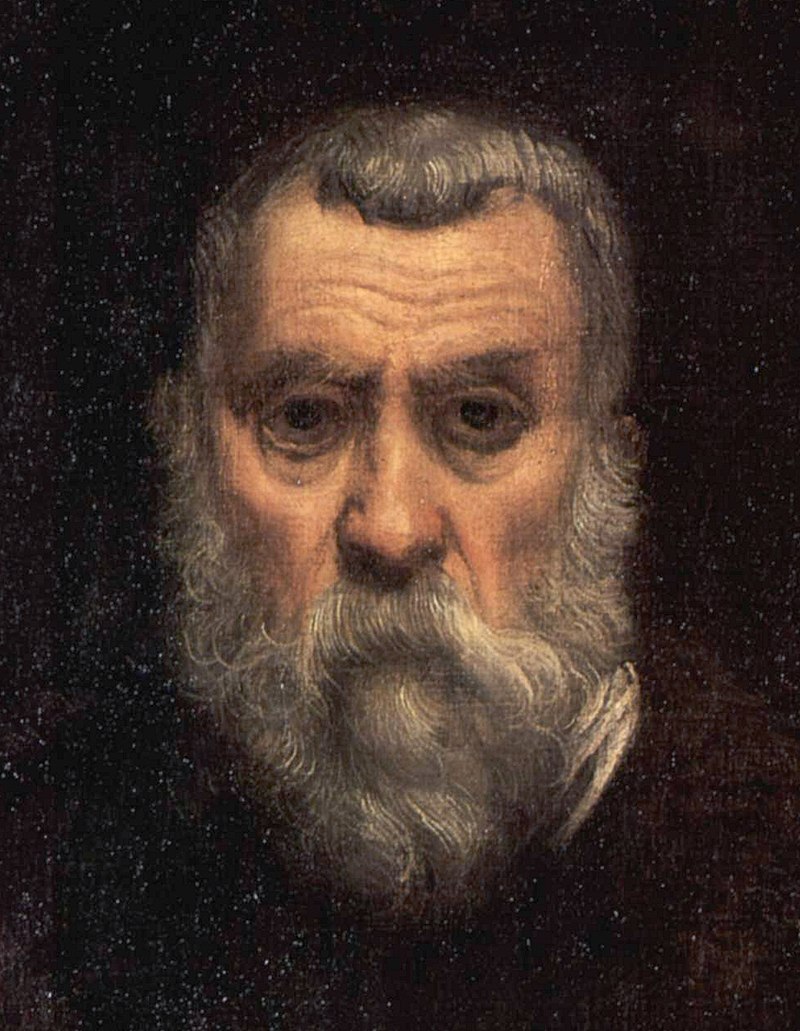 Tintoretto's self portrait in later life.
Tintoretto's self portrait in later life.
Tiziano Vecelli was better known as Titan (pronounced tishan) and would have been around 30 years-old when young Tintoretto came to study under him. Titian’s father was superintendent of the castle of Pieve di Cadore and managed local mines for their owners, as well as being a distinguished councillor and soldier. His grandfather was a notary, as were many of his family, and they were well established in the area around Venice.
Titan had begun his training with Giorgione, but it soon became apparent that the novice had more talent than the teacher. Nevertheless, he continued working with Giorgione on several frescoes and from this distance in time it is difficult to distinguish who painted what. Their styles were so similar and they were constantly adopting improvements from each other. Giorgione died when still young in 1510, but Titan carried on with improving the new art moderna that they had championed. Michelangelo and Da Vinci, though still painting in their old style, were suddenly old school. Historians of art describe this period as the transition from High Renaissance to Mannerism. Needless to say Titan was in great demand, though his work showed the influence of his dead friend and rival with its bold and expressive brushwork. He was the rising star and darling of Venetian art.
Then along came young Tintoretto. The boy worshipped Titan, but for some reason, within the first few days, he incurred the displeasure of the master. The rejection of Tintoretto by Titan was catastrophic and final, and the boy was expelled from his studio. History has left no clues as to why this happened, but from then on Titan and his many followers disparaged Tintoretto relentlessly.
Poor Jacopo did not give up, and instead worked with craftsmen who decorated furniture with paintings of mythological scenes, and when not occupied with this, he practised his painting and studied alone. He was, for most of the time, penniless, but he had his own studio and he wrote his high ideals over the door. Il disegno di Michelangelo ed il colorito di Tiziano: Michelangelo’s drawing and Titian’s colour".
Tintoretto was not without friends, and he worked with Andrea Schiavone, who was gaining commissions for frescos. Tintoretto often worked for nothing, which needless to say attracted commissions, but most of his early work has been lost to time. Two more paintings which are lost, but are remembered only because Titan was recorded expressing his praise of the work, was a portrait of Tintoretto with his brother, and an unknown historical painting. Significantly, both works attracted the praise of the Venetian public. Some of his early paintings had been attributed to Schiavone, but recent scrutiny (2012) has revealed that The Embarkation of St Helena, The Discovery of The True Cross and St Helen Testing The True Cross, are works by Tintoretto. He was also gaining another reputation from his growing fans. People who saw him paint were amazed at the speed and ferocity with which he painted. He gained another nickname; Il Furioso; the furious.
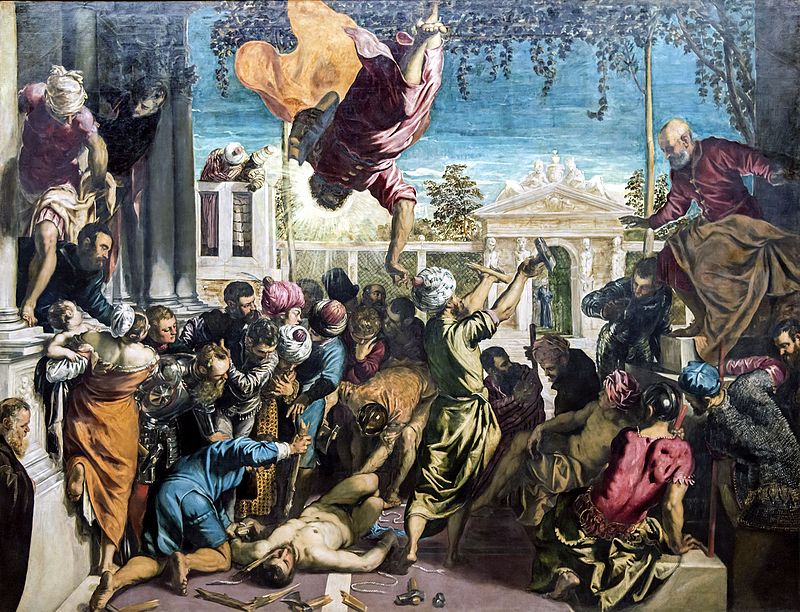 The miracle of the slave.
The miracle of the slave.
His big break came with a commission for a large fresco for the Scuola di S. Marco entitled the Miracle of the Slave. Tintoretto fully realised the significance of the opportunity, and spent hours composing the picture before he started painting. He made full use of the drama and theatre of the scene and used unusual colours applied with his, by now famous, vigorous execution. The painting was a resounding success, and brought him several commissions one of which was for the Church of San Rocco and called Saint Roch Cures the Plaque Victims. This would be the first of his many laterali paintings, in which he displayed an amazing grasp of off-centre perspective. When he painted these wall scenes he realised that the congregation would view the frescos from below and at an angle, so he elongated the scene so that, to them it, looked in perspective.
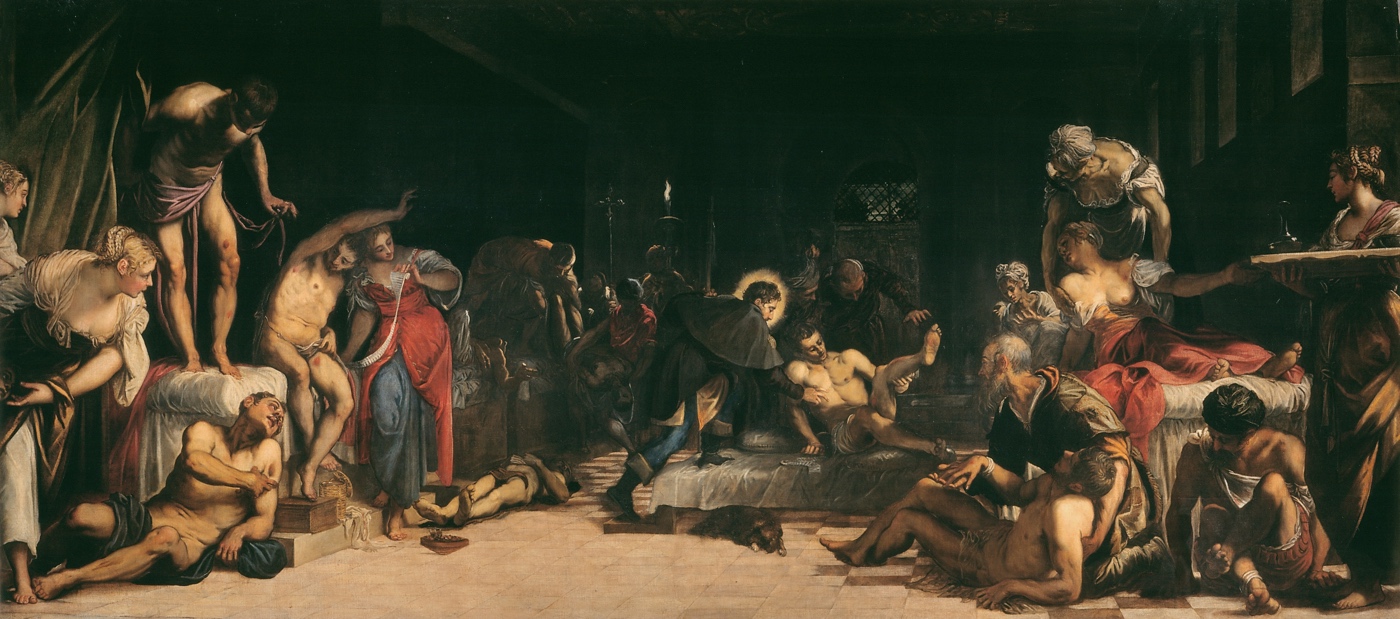
Saint Roch Cures the Plaque Victims. This picture has been digitally corrected, but the one in the church is foreshortened to the bottom RH corner for viewing by the congregation.
His next big break came in 1550 when he married Faustina de Vescovi, daughter of a Venetian nobleman who was the guardian grande of the Scuola Grande di San Marco. Faustina bore him several children, but his firstborn daughter, Marietta, attracted the gossips in Venice who rumoured that she was conceived before his marriage to Faustina. In any event, Faustina turned out to be a loving wife and a good housekeeper. Furthermore, Marietta turned out to be quite an accomplished portrait painter. Faustina brought him happiness and in 1564, more commissions for the Scuola di S. Marco: The Finding of the body of St Mark, the St Mark's Body Brought to Venice and St Mark Rescuing a Saracen from Shipwreck. But Tintoretti often did not get paid for his work. He was still well down the pecking order in the artists of Venice, and he sometimes offered to paint his frescos for nothing just to get his toe in the door. Faustina learned to be careful with her money, and when Jacopo went out she would wrap money in a handkerchief and expect a full account of his spending. Invariably he returned with empty pockets, explaining that he gave the money to the poor. He was an agreeable, witty person to talk to, but rarely smiled and he kept his work techniques secret. Sometimes he retreated to his study, where even his closest friends were not permitted to enter.
Titan, meanwhile, had gone from strength to strength, and by 1521he was nearing the peak of his career. His painting of St. Sebastian for the papal legate in Brescia brought him numerous commissions and numerous copiers of his works. He simultaneously produced The Death of St. Peter Martyr (1530), for the Dominican Church of San Zanipolo, and a series of small Madonnas like the Virgin with the Rabbit (Louvre). Titan, along with Giovanni Bellini, was commissioned to paint three large mythological scenes for Alfonso d'Este in Ferrara. Alfonso had created perhaps the most beautiful gallery of all time which gained fame as camerino d'alabastro (small alabaster room) in which he intended to hang the paintings of the most famous artists of the age.
For the camerino Titan produced The Bacchanal of the Andrians and the Worship of Venus (Now in the Museo del Prado), and Bacchus and Ariadne. (National Gallery London) Between 1530 and 1550 Titan and his studio artists were working flat out and his style was praised and copied everywhere. But he had neglected his contracts to paint for the Venitian government and they ordered him to refund the money they had paid him in advance. They asked his growing rival, Il Pordenone, to take his place. Pordenone died a year into the job, and a subdued Titan returned to honour the contracts. His material fortune was equal to Raphael and Michelangelo and in 1540 he received a pension from d'Avalos, Marquis del Vasto, and an annuity of 200 crowns (which was afterwards doubled) from Charles V from the treasury of Milan. He owned a villa in the Conegliano hills north of Venice, which is now known mostly for the production of wine, especially Prosecco. In 1546 he was given the freedom of the city of Rome. Four years later, he was summoned to Augsberg to paint Charles V and others. Whilst he was there, he painted the portrait of Philip II which was sent to Queen Mary of England, whom Philip later married. For the last 26 years of his life he worked for King Philip and mainly produced portraits of the nobility of Europe. At Philip’s request, he painted a series of large mythological paintings known as the poesie, mostly from Ovid, which scholars regard as among his greatest works. So many artists were copying his paintings that it’s difficult to separate the real ones from the fakes now.
The Black Death raged through Venice in 1576, and though he escaped the pestilence, Titan developed a fever and died in August that year. Soon after, his only son and heir, Orazio, died of the plague. Neither had thought to make out a will, and settling the estate of Titan took decades.
So, I hear you asking, where does the Last Supper come into this story?
Well, Tintoretto painted no less than 9 Last Suppers. Eight of them were in the style of Da Vinci, but the last was radically different. He swings the table around to create an offset viewpoint and then populates the canvas with a multitude of servants who are supplying the disciples with rich food, wine and fruits. But then he adds a host of unseen angels in the air around them, and you become aware that this instant is the defining moment of Christianity. Hardly the quiet supper after arriving in Jerusalem that the New Testament describes, but a painting which says that Jacopo was his own man, and that though self-taught, he could be counted with some of the finest artists the world has ever seen.
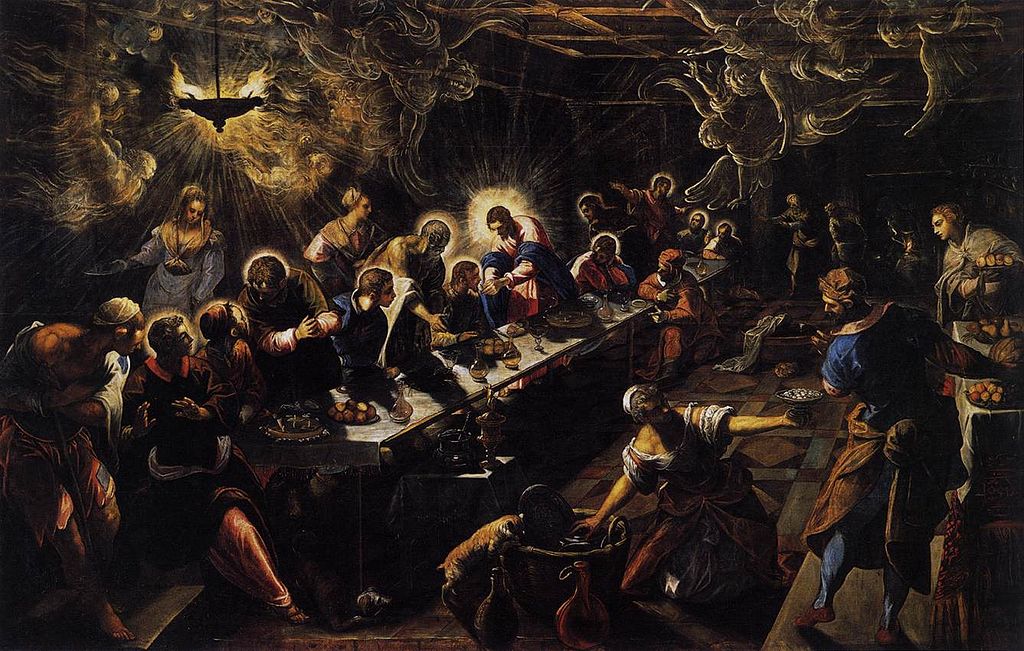 The Last Supper
The Last Supper
The elders of Venice had not forgotten their other son, and twelve years after Titan’s death, they asked Tintoretto to paint a picture for the Dodge’s palace. He was 70 years-old by then, and he had no pupils, so he and his son, Dominico, painted Paradise together. The work is the largest ever oil painting on canvas at 74 by 30ft (22x7 meters) with around 500 detailed figures. It took months to complete, and when it was unveiled all Venice came to see it and praise the artist. He was told that he could name his price for the work, but humble Tintoretto asked just for his expenses during the work to be reimbursed.
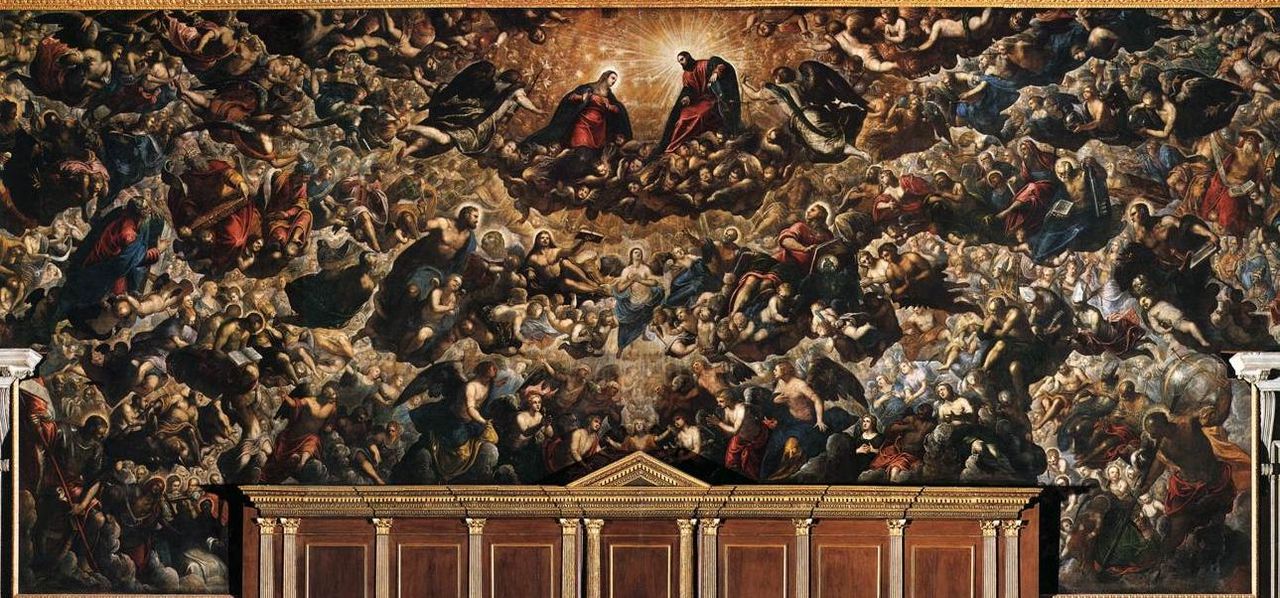 Paradise
Paradise
If you think that this is the end of the Last Supper you are wrong. It was a popular theme, and one which artists could use to further their careers.